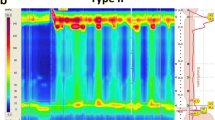Abstract
Prolonged ambulatory esophageal pH and pressure monitors are being developed to evaluate noncardiac chest pain. This new technology needs comparison with conventional esophageal tests before determining which studies are most useful in diagnosing and treating esophageal chest pain. Therefore, we studied 45 patients with esophageal manometry, acid perfusion and edrophonium tests, and 24 hr pH and pressure monitoring. Manometry was abnormal in 20 patients (44%) with nutcracker esophagus, the most common motility disorder. Fifteen (33%) had positive acid perfusion test and 24 (55%) positive edrophonium test. During ambulatory monitoring, all patients experienced chest pain with a total of 202 individual events: 32 events (15%) secondary to acid reflux, 15 (7%) secondary to motility abnormalities, 7 (3%) to both pH and pressure changes, and 149 events (74%) occurred in the absence of any abnormal pH or motility changes. Patients with normal manometry were significantly (P<0.01) more likely to have acid reflux chest pain events than did nutcracker patients, who had an equal frequency of pH and motility events. A positive acid perfusion test was significantly associated with abnormal pressure events (P=0.02; odds ratio 5.95), while a positive edrophonium test more likely predicted acid reflux chest pain during 24-hr monitoring (P=0.007; odds ratio 7.25). Therefore, abnormal manometry and positive provocative tests point to the esophagus as the likely source of chest pain. However, ambulatory pH and pressure monitoring are required to accurately define the relationship between chest pain and acid reflux or motility disorders. Acid reflux is the most common identifiable cause of esophageal chest pain, while motility disorders are much less frequent than previously suggested by laboratory tests.
Similar content being viewed by others
References
Richter JE, Bradley LA, Castell DO: Esophageal chest pain: Current controversies in pathogenesis, diagnosis, and therapy. Ann Intern Med 110:66–78, 1989
Janssens J, Vantrappen G, Ghillebert G: 24 hour recording of esophageal pressure and pH in patients with non-cardiac chest pain. Gastroenterology 90:1978–1984, 1986
Peters L, Maas L, Petty D, Dalton C, Penner D, Wu W, Castell D, Richter J: Spontaneous noncardiac chest pain. Evaluation by 24-hour ambulatory esophageal motility and pH monitoring. Gastroenterology 94:878–886, 1988
Breumelhof R, Smout AJPM, Breedijk LMA, Akkermans JHSM: Esophageal motility and gastroesophageal reflux in non-cardiac chest pain. A quantitative analysis of 24-hour data. Gastroenterology 96:A59, 1989
Richter JE, Wu WC, Johns DN, Blackwell JN, Nelson JL, Castell JA, Castell DO: Esophageal manometry in 95 healthy adult volunteers. Dig Dis Sci 32:583–592, 1987
Katz PO, Dalton CB, Richter JE, Wu WC, Castell DO: Esophageal testing of patients with noncardiac chest pain and dysphagia. Results of three years' experience with 1161 patients. Ann Intern Med 106:593–597, 1987
Richter JE, Hackshaw BT, Wu WC, Castell DO: Edrophonium: A useful provocative test for esophageal chest pain. Ann Intern Med 103:14–21, 1985
Weiner GJ, Morgan TM, Cooper JB, Wu WC, Castell DO, Sinclair JW, Richter JE: Ambulatory 24-hour esophageal pH monitoring: Reproducibility and variability of pH parameters. Dig Dis Sci 33:1127–1133, 1988
Weiner GJ, Richter JE, Cooper JB, Wu WC, Castell DO: The symptom index: A clinically important parameter of ambulatory 24 hour esophageal pH monitoring. Am J Gastroenterol 83:358–361, 1988
Hewson EG, Sinclair JW, Dalton CB, Wu WC, Castell DO, Richter JE: The acid perfusion test: Does it have a role in the assessment of noncardiac chest pain. Gut 30:305–310, 1989
Bernstein LM, Baker LA: A clinical test for esophagitis. Gastroenterology 34:760–781, 1958
Lee CA, Reynolds JC, Ouyang A, Baker L, Cohen S: Esophageal chest pain: Value of high-dose provocative testing with edrophonium chloride in patients with normal esophageal manometries. Dig Dis Sci 32:682–688, 1987
Nasrallah SM, Hendrix EA: Comparison of hypertonic glucose to other provocative tests in patients with noncardiac chest pain. Am J Gastroenterol 82:406–409, 1987
Barish CF, Castell DO, Richter JE: Graded esophageal balloon distension: a new provocative test for noncardiac chest pain. Dig Dis Sci 31:1292–1298, 1986
Goudot-Pernot C, Champignealle B, Bigard MA, Gaucher P: Prospective comparative study of esophageal balloon distention and edrophonium provocative study of esophageal balloon distention and edrophonium provocation in 50 patients with noncardiac chest pain and in 12 healthy controls. Gastroenterology 96:A180, 1989
DeCaestecker JS, Pryde A, Heading RC: Comparison of intravenous edrophonium and oesophageal acid perfusion during oesophageal manometry in patients with noncardiac chest pain. Gut 29:1029–1034, 1988
Vantrappen G, Janssens J, Ghillebert G: The irritable oesophagus—a frequent cause of angina-like pain. Lancet 1:1232–1234, 1987
Ward BW, Wu WC, Richter JE, Hackshaw BT, Castell DO: Long-term follow-up of symptomatic status of patients with noncardiac chest pain: Is diagnosis of esophageal etiology helpful? Am J Gastroenterol 82:215–218, 1987
Cannon RO III, Bonow RO, Bacharach SL, et al.: Left ventricular dysfunction in patients with angina pectoris, normal epicardial coronary arteries, and abnormal vasodilator reserve. Circulation 71:218–226, 1985
Yakshe PN, Catlau EL, Cannon RO III, Maher K, Benjamin SB: Role of provocative testing in differentiating esophageal and cardiac chest pain in patients with microvascular angina and esophageal motility disorders. Gastroenterology 96:A555, 1989
Kahrilas PJ, Dodds WJ, Hogan WJ: Dysfunction of the belch reflux. Gastroenterology 93:818–822, 1987
Shapiro LM, Crake T, Poole-Wilson PA: Is altered cardiac sensation responsible for chest pain in patients with normal coronary arteries? Clinical observation during cardiac catheterization. Br Med J 296:170–171, 1988
Clouse RE, Lustman PJ: Psychiatric illness and contraction abnormalities of the esophagus. N Engl J Med 309:1387–1392, 1983
Hewson EG, Sinclair JW, Dalton CB, Wu WC, Richter JE: A comparison of traditional esophageal tests and 24 hour pH study in noncardiac chest pain. Gastroenterology 96:A208, 1989
DeMeester TR, O'Sullivan GC, Bermudez G, Middell AI, Cimochowiski GE, O'Drobinak JO: Esophageal function in patients with angina-type chest pain and normal coronary angiograms. Ann Surg 196:488–498, 1982
Author information
Authors and Affiliations
Rights and permissions
About this article
Cite this article
Hewson, E.G., Dalton, C.B. & Richter, J.E. Comparison of esophageal manometry, provocative testing, and ambulatory monitoring in patients with unexplained chest pain. Digest Dis Sci 35, 302–309 (1990). https://doi.org/10.1007/BF01537406
Received:
Revised:
Accepted:
Issue Date:
DOI: https://doi.org/10.1007/BF01537406




